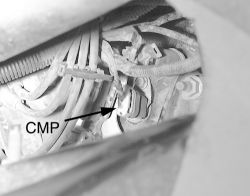Hi guys. Excuse me for butting in but I have a different thought. I think hmac300 is on the right track with fuel pressure but with a different cause. I had a very similar problem about ten years ago with my '88 Grand Caravan caused by a collapsing pickup screen in the gas tank. On this vehicle it only acted up on the very hottest few days of summer, (don't know why), then six months later it really caused a lot of trouble in the middle of winter. That's when my students were able to find it.
One of the clues that I didn't initially understand was the stalling only occurred during coasting down from highway speeds. It ran fine while maintaining highway speeds. The cause wasn't fuel pressure directly; it was fuel volume. Fuel volume moved by the pump goes way up during coasting when the engine actually uses the least amount. During coasting, intake manifold vacuum goes way up. That is one of the forces pulling fuel out of the injectors. The other one is fuel pressure pushing the fuel out. To prevent a rich coast-down condition, there is a vacuum hose attached to the fuel pressure regulator. When vacuum goes up, fuel pressure goes down. The net difference in forces acting on the fuel stays constant that way.
The problem is that by relaxing the spring in the fuel pressure regulator, it is easier for the fuel to flow through the return line and back into the tank. THAT is where fuel volume goes way up even though the amount of fuel going into the engine goes down. With the plugged pickup screen, that higher volume of fuel can't get through, and since it's actually bleeding off through the regulator, pressure drops and causes rough running or stalling.
I've been running my van for the last year with a pressure gauge hooked to the radio antenna because I had a similar situation, but only when pulling a really large tandem axle enclosed trailer that's bigger than the van. Coincidentally, I only drag it around twice a year in July when it's hot again. It turned out to be another plugged pickup screen, but while watching how it acted, I found that the normal fuel pressure of 45 - 50 psi could drop to as low as 20 psi and the engine still ran fine with no symptoms. It was at 15 psi that it started to sputter. Most GM engines are not nearly so forgiving. Some of them will not start or they'll stall when the pressure is just five pounds low.
I had this same problem with two carbureted cars years ago. The time frame you described was exactly the same. They'd run fine for about 20 minutes at highway speed, then they'd feel like they were running out of gas. I learned to just sit on the side of the road for five minutes to give the screen a chance to stretch back out, then I could make it about another five miles before it acted up again.
Now that I understand what was happening on my van, I suspect I could have verified it by disconnecting the vacuum hose from the pressure regulator and plugging it. That would result in too much fuel pressure and black smoke from the tail pipe, but it shouldn't stall.
Normally the engine will stall if the crankshaft position sensor or camshaft position sensor fails, and they often fail by becoming heat-sensitive, then work again when they cool down for a half hour. One possible explanation for the fault codes, and the rough running instead of outright stalling, is that the engine is going too slowly due to the fuel problem and the computer is interpreting that as missing signal pulses from those sensors.
I don't know which engine you have or how the fuel pump is powered, but to turn the tables on my story, the circuit that powers the fuel pump may be getting turned off due to missing pulses from one of those sensors. I'm much more familiar with the Chrysler system but many GM models are similar. You may want to connect a voltmeter or test light to the fuel pump's power wire so you can see if the voltage is going away before the rough running starts. Hmac300 might know if there's a tap on the oil pressure sending unit that keeps the fuel pump powered up, or if the Engine Computer keeps a relay turned on like Chrysler does when it sees the pulses from those two sensors. There will always be a way to turn the fuel pump off when the engine stops rotating. That is done to prevent the pump from continuing to run if a fuel line is ruptured in a crash, creating a fire hazard. You could have a low oil pressure problem at idle or a defective sending unit that is killing the power to the fuel pump. That's where monitoring that voltage could provide a valuable clue.
Tuesday, October 10th, 2017 AT 4:50 PM
(Merged)


